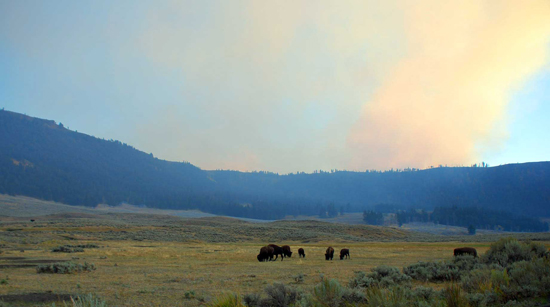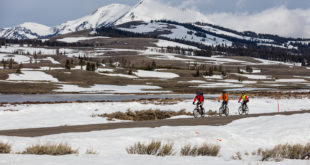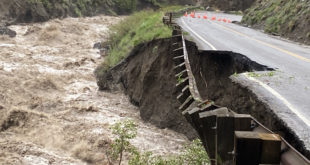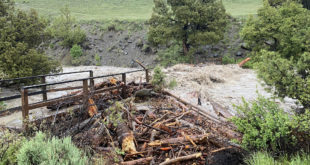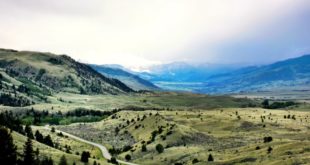Human beings, especially some Yellowstone Park people, do worry. The Antelope Fire, burning on the northeast slopes of Mount Washburn, was a small one — sixty acres or so. It was in that class of fire where the protocols now say, let it burn. It was small; it’s late in the season, snow is just around the corner; the winds take it toward termination at the Yellowstone River gorge; and there are no roads or buildings anywhere near it. The first official response: Don’t worry. Let it burn.
I drove through the smoke several times: Twice back and forth through the Lamar region, and once over Mount Washburn. The first time you could tell it was a small fire, one of several that break out in a typical summer. It was burning a rather picturesque area of mixed forest and meadow quite visible from the highway between Tower and Canyon, especially along a section of the road above Antelope Creek known for its grizzly bear sightings. No grizzlies in the area now, probably. Though it’s a small fire and most animals can avoid it easily, larger animals do not take such risks.
The fire started about September 14, probably by lightning strike. It’s slightly unusual for lightning storms in mid-September, but it happens. This has been a somewhat unusual year, anyway. Much rain has fallen just north of the park in Montana (from Bozeman to Livingston, Big Timber and Billings). However, it’s as if the big sweeping cold fronts from Canada and the moisture from the Pacific Northwest just can’t make it over the mountains north of the park. The rainfall within Yellowstone Park has been spotty. In general, it’s dry, although not too far from normal for early fall.
There is tinder enough. A walk through the Canyon area woods in late August convinced me of that. When the branches and pine cones underfoot emit a crispy crunch, then at least the ground tinder will burn readily. I don’t know what the water content of the trees is this year. That’s the true measurement of an explosive fire situation. When the water content (the amount of water relative to the mass of the tree) sinks below 20 percent, the trees themselves will readily burn. Just before the great fire of 1988, the water content was said to be generally around 9 percent.
Fall weather is more favorable to small fires. There are often high winds in fall, but it’s cooler. Cool, cloudy days with some rain are common. As a rule most forest fires don’t burn for long. There are exceptions. Some years there are long stretches of dry, relatively warm (temperatures in the 70s) and windy days in September. This appears to be one of those years. So as I looked at the smoke column from Lamar Valley, turning pink, orange, and red in the fading sunlight of evening, I wondered about the Antelope Fire.
By September 18 the Antelope Fire was already past the 1,000 acres of coverage, a marker used to gauge a more important fire. The Park Service was beginning to call in a response. Aerial observation was stepped up, a fire crew dispatched, and a tanker plane put at the ready. They would need it.
I was among what seemed to be a throng of cars traveling over the Mount Washburn roadway last Saturday. Not all of the people were there to see the fire, but they could hardly avoid its attraction. Not all forest fires are located with a birds-eye view from a safe distance as the Antelope Fire. The rough pullouts along the highway just north of the May West Curve were full of cars and a definite traffic hazard. Perhaps the people with their big barrel cameras and high-powered spotting scopes were looking for animals fleeing the fire. From this perspective, the distance to the fire seems like very far away.
In reality, however, while most of the fire was burning toward the Yellowstone Canyon (which it presumably cannot leap), it continued to inch itself northward as well. Antelope Creek, a tiny brook in a pleasant glen, runs parallel to the park road and comes out not far from the buildings of Tower Falls. A fire moving in that area could present some serious problems. Which is what happened by Sunday, September 19.
As is usually the case, tricky high winds -– this time from the southwest -– pushed the fire more rapidly northward. The fire burn was put at 1,600 acres. More fire crews, fire trucks, and aerial equipment were brought in because now the fire potentially threatened buildings. The smoke at points along the park road near Tower, and the need for fire-fighting vehicles to move freely, forced the closure of the park road — first intermittently, and then more permanently.
By Monday, September 20, the Park Service had mobilized considerable resources to fight the fire. This isn’t a story with a known ending. The weather fluctuates, but we’re due for more than a week of above average temperatures, high winds, and little precipitation. That’s how little fires keep going -– keeping moving towards areas of available fuel. In this case, the Antelope Fire has halted its advance toward Tower, and is moving south by southwest – back toward Mount Washburn. As of Tuesday, it is said to have burned over 2,200 acres and to be 20 percent contained.
By historical standards, it’s still a small fire. That doesn’t make it more predictable or less a threat to property. The Antelope Fire is a good example of how uneasily nature and human culture coexist, but I really shouldn’t make too big a deal out of this. It’s just a small fire. –Nelson King. Contributing editor King’s SciTechStory site tracks the impact of science and technology.
Photo by Nelson King.
RELATED STORIES: Antelope Fire Now at 2,199 Acres, Moving South; Antelope Fire Expands to 1,600 Acres; Antelope Fire Now at 60 Acres; Two Small Fires Emerge in Yellowstone
We’ve also set up a free Twitter account so you can receive updates on the device of your choice.
 Yellowstone Insider Your Complete Guide to America's First National Park
Yellowstone Insider Your Complete Guide to America's First National Park
